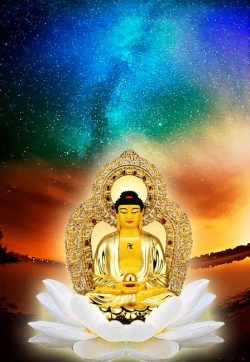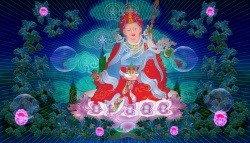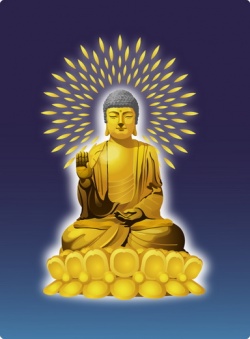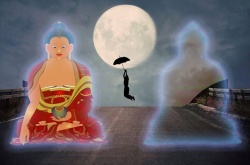If no-self, why are you following your body?
Someone wrote: "How can you say there is no self, no center of perception, when "your" body is always being followed? I suppose it doesn't really matter if there is a center of perception as long as the center is clearly not identified with, tho it might be subtly identified with perhaps?"
I replied:
In your model, the universe is made up of many different circles. Each circle represents an individual's experience. And within each individual circle, there is a dot or eye at the center, which represents the agent or center or perceiver of experience that sees/knows/feels the field of experience. The eye or center cannot see beyond that circle.
In actuality there is no center. In other words, the seeing/hearing/sensing/cognizing/thinking field is simply a self-cognizing sensations, perceptions, etc. The circle is a self-luminous, self-aware circle with no center or perceiver apart from perceiving/perception. There can be a perception of a center, but there is never a center of perception. Even that perception of a center is just another perception, no different from another sight or sound as part of the field of perceptions/sensations. Clear seeing (realization of anatta) will eliminate the perception of a center (after insight there can still be a trace of self but will also gradually be released with practice).
Furthermore, we have to penetrate dependent origination. This is where net of indra comes in. Each circle, each node, in the universe is a reflection of all other nodes. There is no universal self underlying all nodes, but instead, one node reflects all nodes. All nodes are manifestation of total exertion of the universe. This is also where our holographic nature can be seen. Omniscience is possible not because there is a universal Self subsuming all, but because of our interconnectedness and emptiness. Psychic phenomena happen because of the non-local nature of dependent origination.
...a while later I wrote...
I'm not sure what you mean by 'your body is being followed'. But what I can tell you here is that the construct or sense of a body being here has dissolved... and Goenka describes this very well when he said, "...Then working with both you reach the stage of feeling sensation throughout the body—sabba-kāya. Initially it is very gross, solidified, intensified, but as you keep practising patiently, persistently, remaining equanimous with every experience, the whole body dissolves into subtle vibrations, and you reach the stage of bhaṅga, total dissolution. Having started with natural breath, you learn to reach the important station of feeling sensations in the whole body in one breath: from top to bottom as you breathe out, from bottom to top as you breathe in..."
There is no denial of anything, just that everything dissolves into luminous vibrations
...a while later I wrote...
Oh ok I think I get what you mean. It seems that you think (and feel) that there is an observer that follows the body around and experiences the body. Like the third-person camera view that follows around a character in a video game like GTA. This is false because first of all as explained above, the 'body' is really just an imputed construct, like a placeholder with a supposed fixed shape and boundaries, but when we see through the construct then there is just vibrant patterns of energies and dissolution of a substantial mind-body. We literally feel no boundaries and instead vibrant energies that is disjoint yet in total exertion.
Secondly there simply was never an observer who can 'follow' or 'observe' anything. Sensations are self-luminous, meaning, sensation feels, no feeler involved. Scenery (i.e. vision) sees, no seer. They simply happen and are aware-ing so to speak. There is no such thing as an inner person inside the head looking out there at the world as depicted in cartesian dualism ( http://www.overthinkingit.com/.../cartesian_theater... ). There is in seeing just scenery, full stop. In hearing just sound. That is anatta (later should go into twofold emptiness).
Another thing I think it's important to point out is that the so called 'circle' or 'mindstream' is simply another placeholder, another conventional label or imputation. There is no real 'circles' or 'mindstreams'... it is like h2o is empty of being an entity or having a substance called 'water' but due to the aggregation of two hydrogen atoms and one oxygen atom, a conventional label is applicable called 'water molecule'. Yet there is no such thing as a core or waterness that resides in the center of the three molecules connecting and coordinating them. No waterness of water can be found apart from imputation. Likewise due to the five aggregations or skandhas the conventional label 'person' is applied but in actuality there is no real person or soul or core. And likewise, 'mind' is a conventional label for the four mental aggregates, which are all self-luminous, manifesting transience that dependently originates and is fundamentally empty and non-arising.
As 3rd Karmapa says, "Mind is no mind--the mind's nature is empty of any entity that is mind
Being empty, it is unceasing and unimpeded,
manifesting as everything whatsoever."
One last point.
It is important not to subsume subject-object into Self, as that can either mean subsuming into a universal consciousness, or leads to seeing that everything is self and therefore other mindstreams are subsumed into self, which is sollipsistic. Both are false views. The point is to see through inherency, not to subsume one pole to another (either object into subject, or subject into object).
Conventionally, water is still water, and is not the same as for example, carbon dioxide molecule. The point is not to collapse all types of molecules into one 'water substance', but to see through the inherency and touch the manifestation and dependencies. Likewise I am still I, you are still you, conventionally. Through insights into anatta and emptiness we see through the inherency of Self, mind, body, and therefore experience becomes direct gapless self-luminous because there is no more imputing the perception of inherent subjectivity and objectivity and instead one penetrates the reification and touch the suchness of the six entries. Yet there is no absolutist claims like 'There is only THIS' or 'There is only SELF' or 'There is only X and no others', etc, which is really still an essentialist/substantialist/inherent view.
This is an interesting topic.
I do not fully understand the second question posted by the person who wrote.
But I guess, his question is basically anyone who would ask when he come across the topic of Anatta (No-Self).
Because most people would think this way:
"This body is mine, I can see with my eyes, listen to music with my ears, taste the food with my tongue, think/analyze what I had learnt, feeling pain/sadness when someone insult/hurt me..
Surely myself is I..!?”
Perhaps if we were to look at Anatta-lakkhana Sutta, we may have some understanding on how Lord Buddha describe No-Self):
http://www.accesstoinsight.org/tipitaka/sn/sn22/sn22.059.nymo.html
In the deer park, the Lord Buddha said "Bhikkhus, form is not-self. Were form self, then this form would not lead to affliction, and one could have it of form: 'Let my form be thus, let my form be not thus.' And since form is not-self, so it leads to affliction, and none can have it of form: 'Let my form be thus, let my form be not thus.'
….
"Bhikkhus, how do you conceive it: is form permanent or impermanent?" — "Impermanent, venerable Sir." — "Now is what is impermanent painful or pleasant?" — "Painful, venerable Sir." — "Now is what is impermanent, what is painful since subject to change, fit to be regarded thus: 'This is mine, this is I, this is my self'"? — "No, venerable sir." (end of extract)
Thus in the discourse, the Lord Buddha explained the same concept of no-self with the other 4 of the five aggregates.
I believed our misconception of ‘I/self’ is due to not seeing things as they really are (avijja), although through our senses we think there is an ‘I’ and all our possessions are ‘mine’. But failing to understand that we cannot control any of them as wished.
Thus the Lord Buddha further explained that other than we can’t control any of our possessions, our possessions are impermanent therefore leads to suffering/un-satisfactoriness (dukkha).
Talking about clinging to our body..I can’t help but recalled this.. I heard that there is one monk from Thailand, the temple had recently held his cremation ceremony but he passed away 3+years ago because he donated his body to the University’s medical school.
Actually we can also donate our body to NUS’s medical school. Similarly, they probably will keep our body for study for 2-3 years.. But frankly speaking, I can’t imagine and I don’t know why, but I don’t think I will be willing to donate my body even though I’m already dead.. :)
Thanks for your sharing and honesty about the deep unwillingness to relinquish ownership of body. As Buddhists we must be aware of the deep I and mine making, that is what makes us unwilling to cut off our organs or legs or hands and give it to someone else. Let's not even speak about our own organs... if you have sons and daughters, you will feel deep sadness when one of them dies or some mishap happens. Or if you are a billionaire or millionaire, imagine losing all your money overnight during a financial crash or recession. It is truly painful only due to the I and mine making, sense of ownership, possessiveness. We don't feel much pain when someone else loses their money or children. It is only possible for us to overcome this bond through meditating on the dharma, dependent origination, anatta, anicca, until deep wisdom completely clears our bonds. That is why we practice.
What you said about control is also very important. There are a few aspects to anatta.
As the teachings point out, there are Four Kinds of Clinging to Self
There are four kinds of clinging to self arising out of the belief in a self or soul.
1.Clinging to Self as the Master (Sāmi Atta)
2.Clinging to Self as an Abiding Soul (Nivāsī Atta)
3.Clinging to Self as the Doer (Kāraka Atta)
4.Clinging to Self as the Experiencer (Vedaka Atta)
My highly experienced friend Piotr Ludwiński also wrote before:
In anatta agency is resolved in four aspects;
Firstly it's resolved that there is only foreground manifestation without background; instead to there being two (experiencer-experienced) or three (experiencer-experiencing-experienced) things it's resolved that in reference to what is experienced there is precisely only what is experienced. This is resolving that self as witness/observer is non-arisen since it depends on imputation.
Secondly it's resolved that in that naked foreground manifestation there is no active subject endowed with cognitive or productive abilities/capacities. This is resolving that self as controller/doer is non-arisen since it depends on imputation.
Thirdly it's resolved that in that naked foreground manifestation without both active and in-active subject there is not a single phenomenon that could be said to be "mine". This is resolving that self as owner/posessor is non-arisen since it depends on imputation.
Last aspect... Is to resolve that there is no pervailing substance/beingness/awareness that remains unchanged... No global source for naked manifestation and likewise no "the awareness" and the like. This is resolving that self as universal selfhood is non-arisen since it depends on imputation.
First aspect is that there is no receiving end for thought... Just thought without background against which it appears.
Second aspect is that we don't find any thinker behind thoughts who is emitting them.
Third aspect is that we don't find any thought that we could pin down as "mine", belonging to "me".
Fourth aspect is that we don't find any universal unchanging essence in any possible relationship to thoughts (identical with them, different from them, being in them, containing them or possessing them).
Sentient being is conventional term when there is ignorance, attachment and aversion... and delusion of self-view that solidifies this process of grasping into substantial being. Meaning sentient being is term for grasping at self as
a)observer/witness
b)controller/doer
c)owner
d)abiding soul/being/essence/source
When it's directly resolved in one's own mindstream both poles of sentient and insentient are seen to be delusory... If something that was posited as sentient is non-arisen exactly to what we could compare "insentient"? How many one-sided coins we could find?
.....
later, Piotr also wrote:
This is short commentary about one aspect that is missing in my latest article… http://awakeningtoreality.blogspot.com/2014/02/anatta-and-sentient-being.html
I’ve emphasized aspects that can be said to correspond to Thusness’ “first stanza” from http://awakeningtoreality.blogspot.com/2009/03/on-anatta-emptiness-and-spontaneous.html
But I’ve not mentioned “second stanza” aspect.
When there is no grasping at observer, doer…
When there is no referencing sound to background
And no referencing it back to hearer hearing
That sound is instant illumination…
Without being obstructed by subjective reference point that mediates it’s arising…
Sound manifest as vividly as it can.
“When self becomes more and more transparent, Likewise phenomena become more and more luminous.”
Like Thusness wrote above.. When there is no subject to protect and no one who could escape from “stuff of life”… Sensory appearances can shine brightly as intensely as they can as instant clarity. Without dullness that comes from wanting to escape and dissociate from appearances… Without dullness that comes from discarding them for sake of abiding as imagined Absolute.







